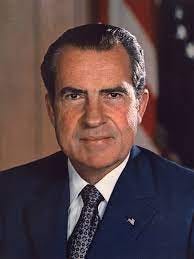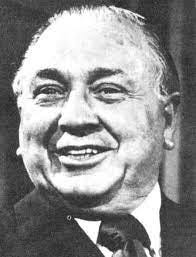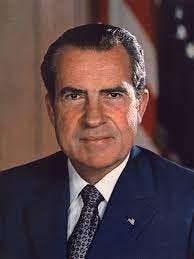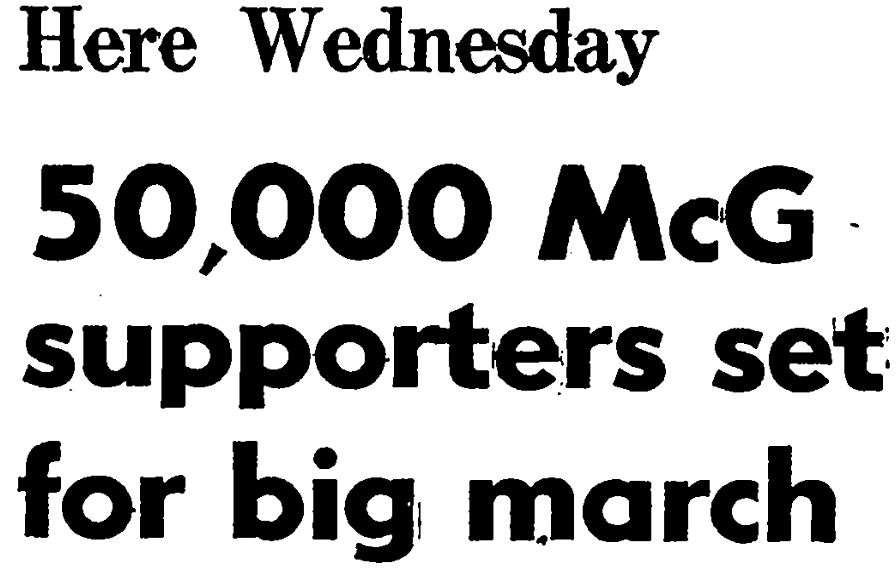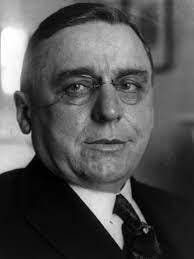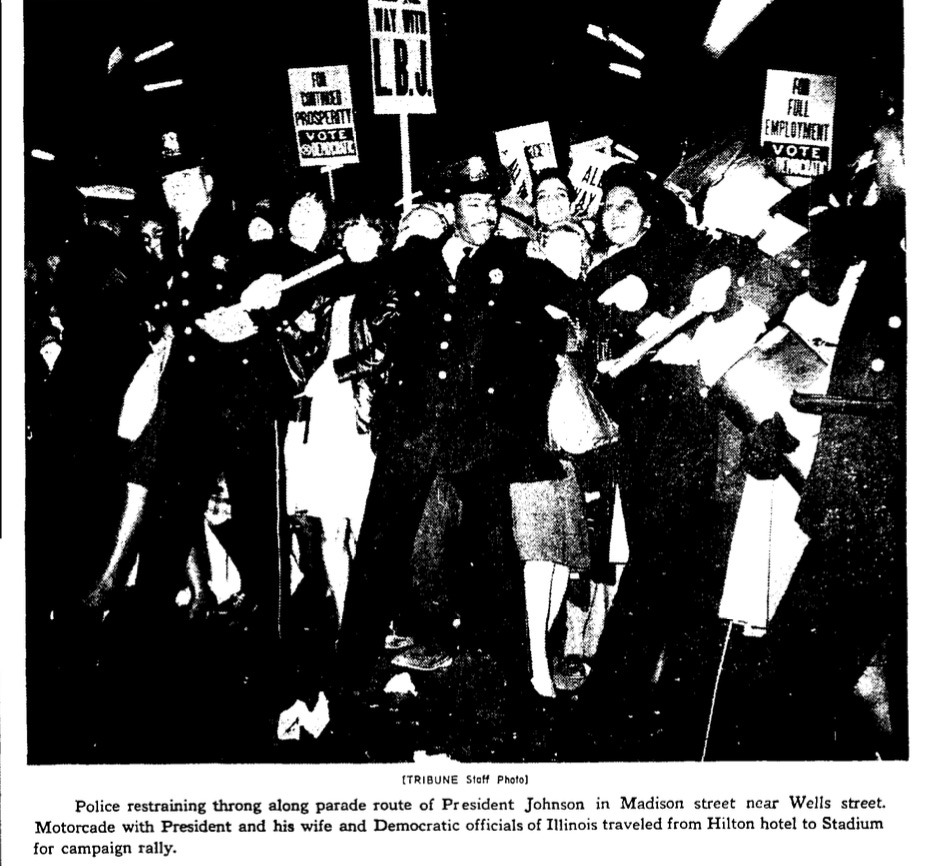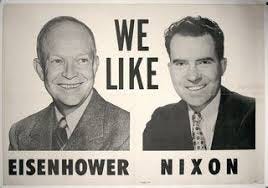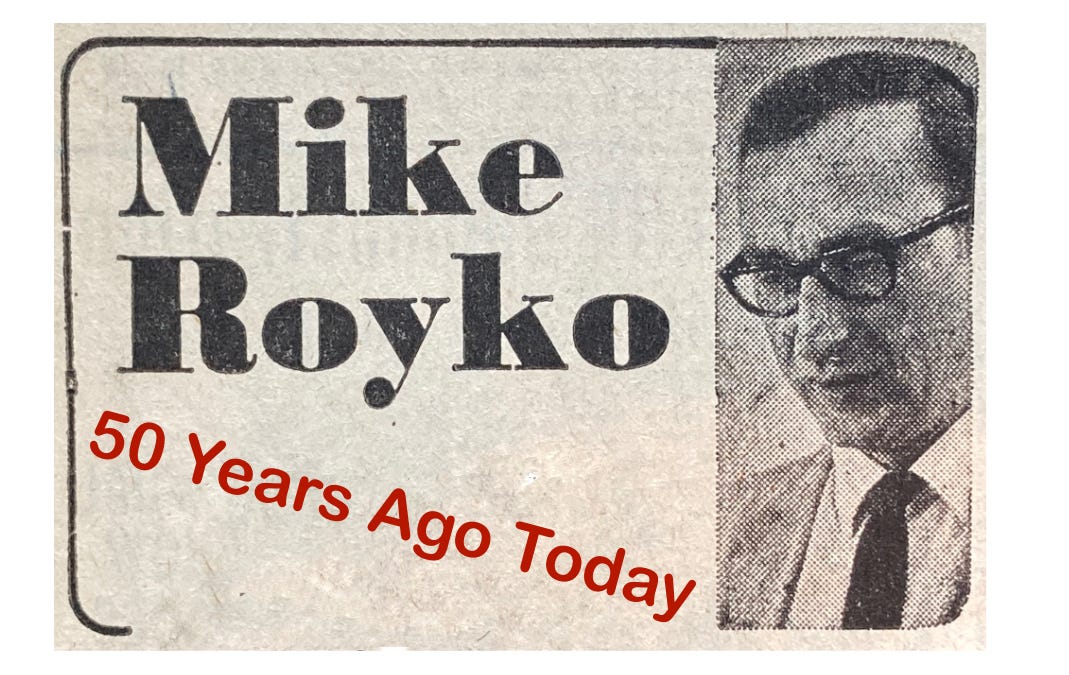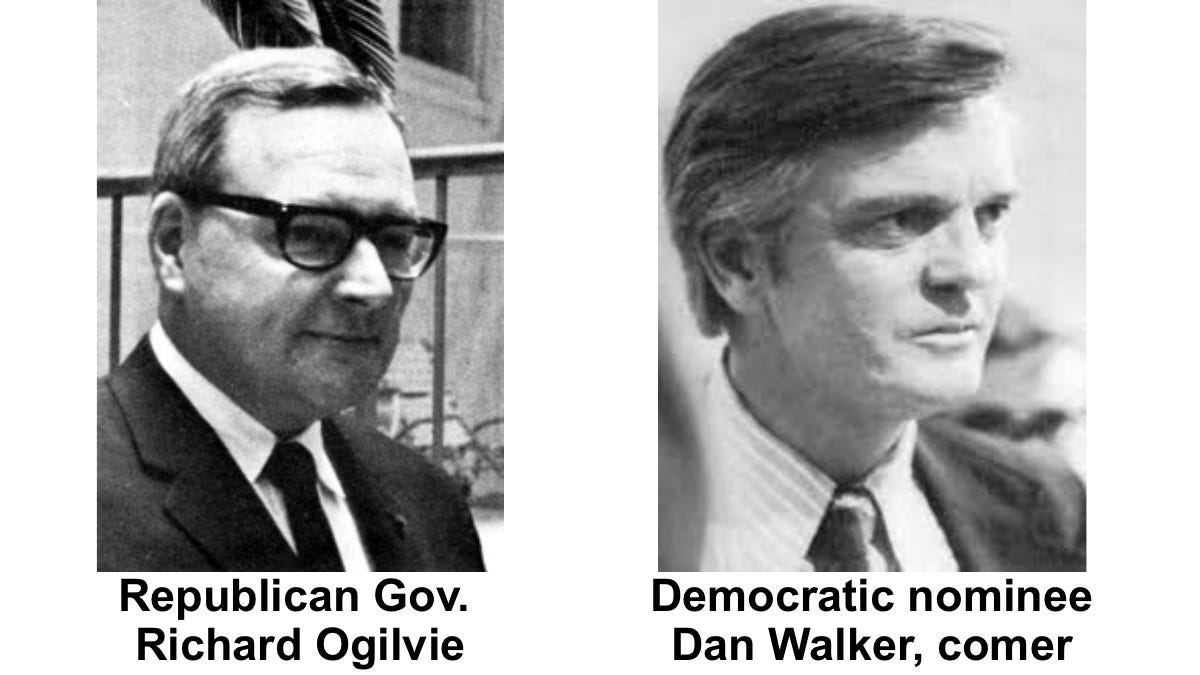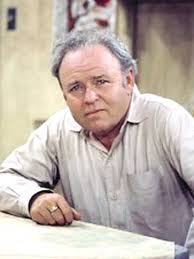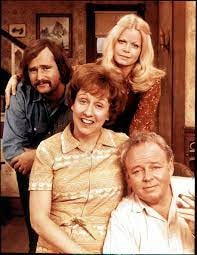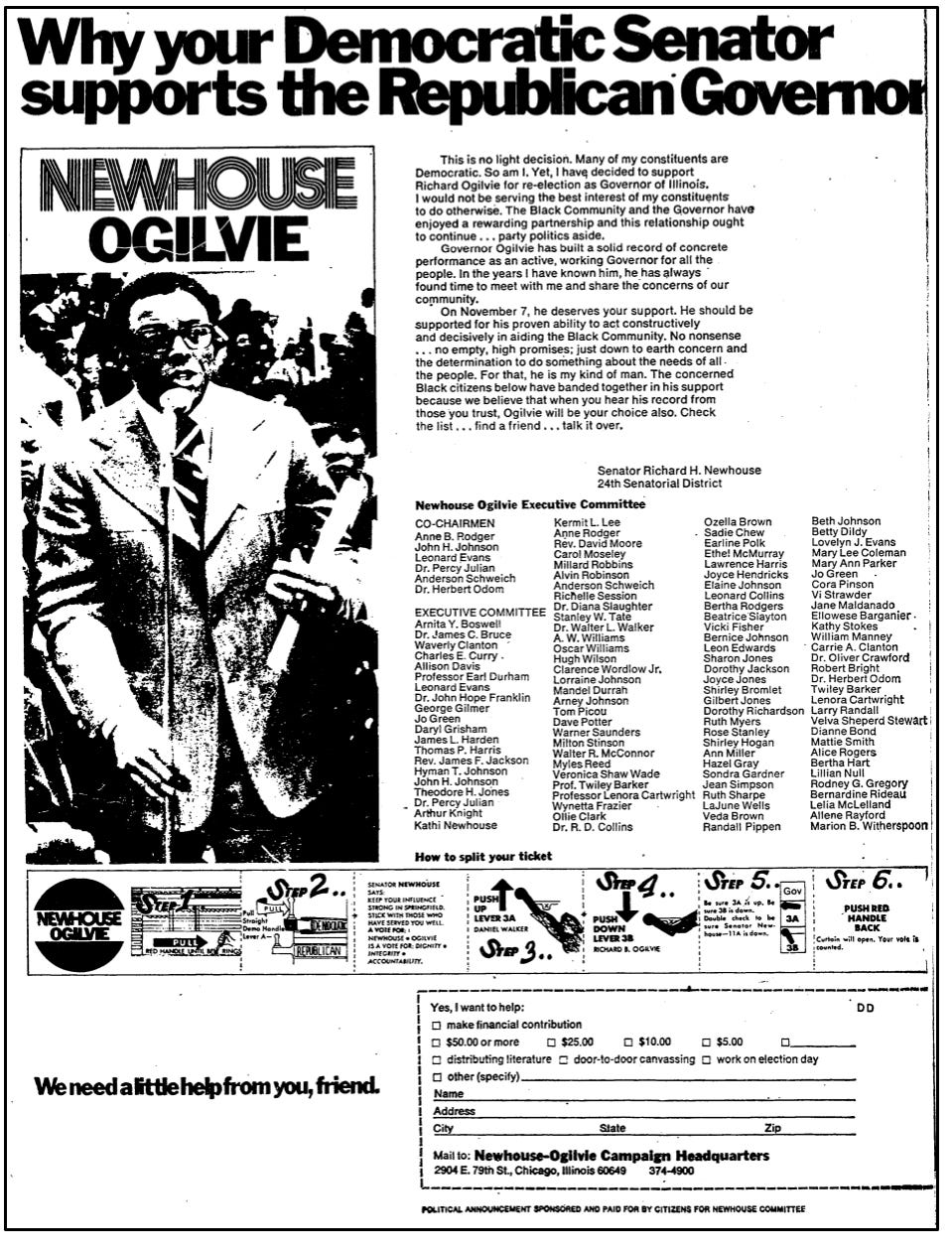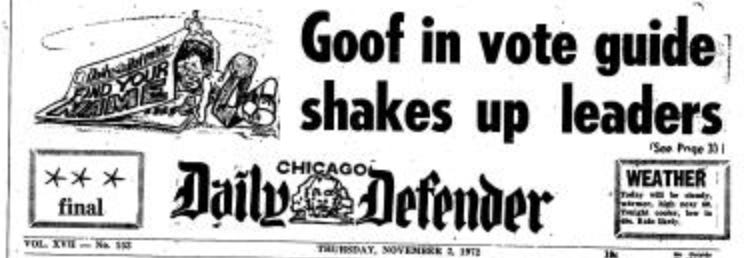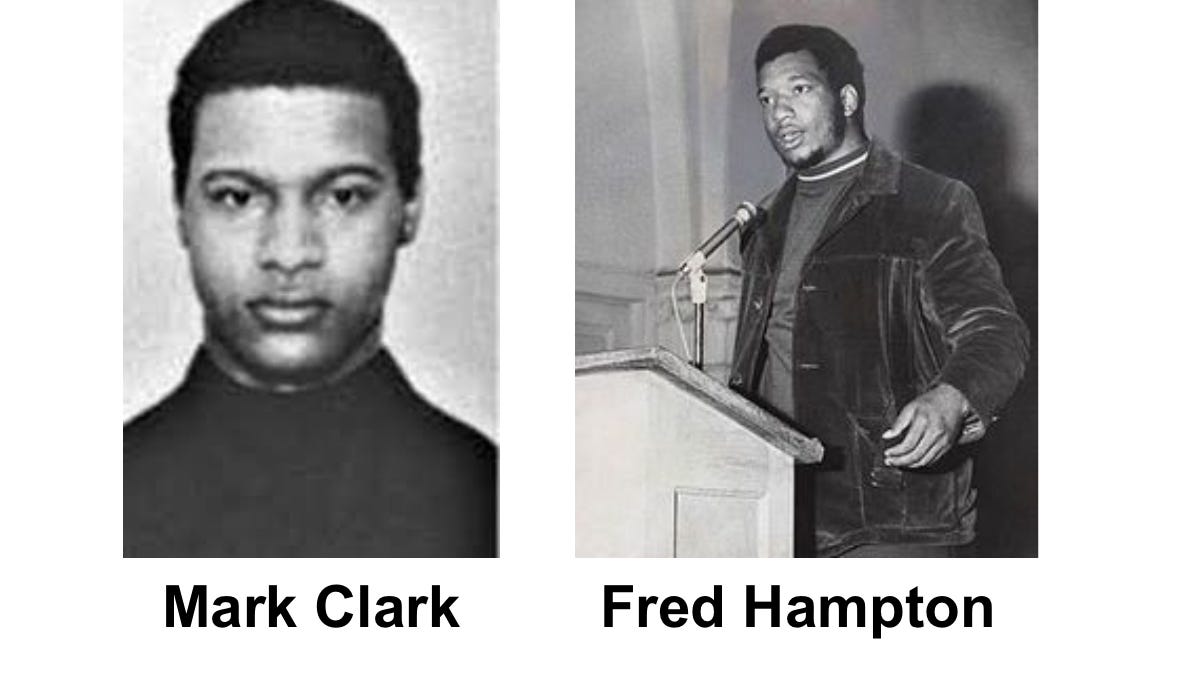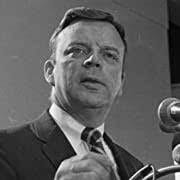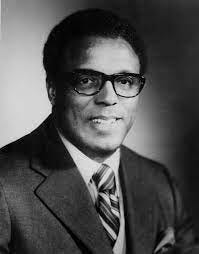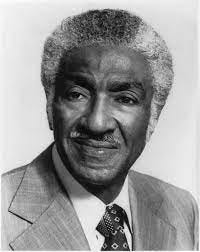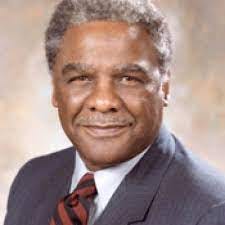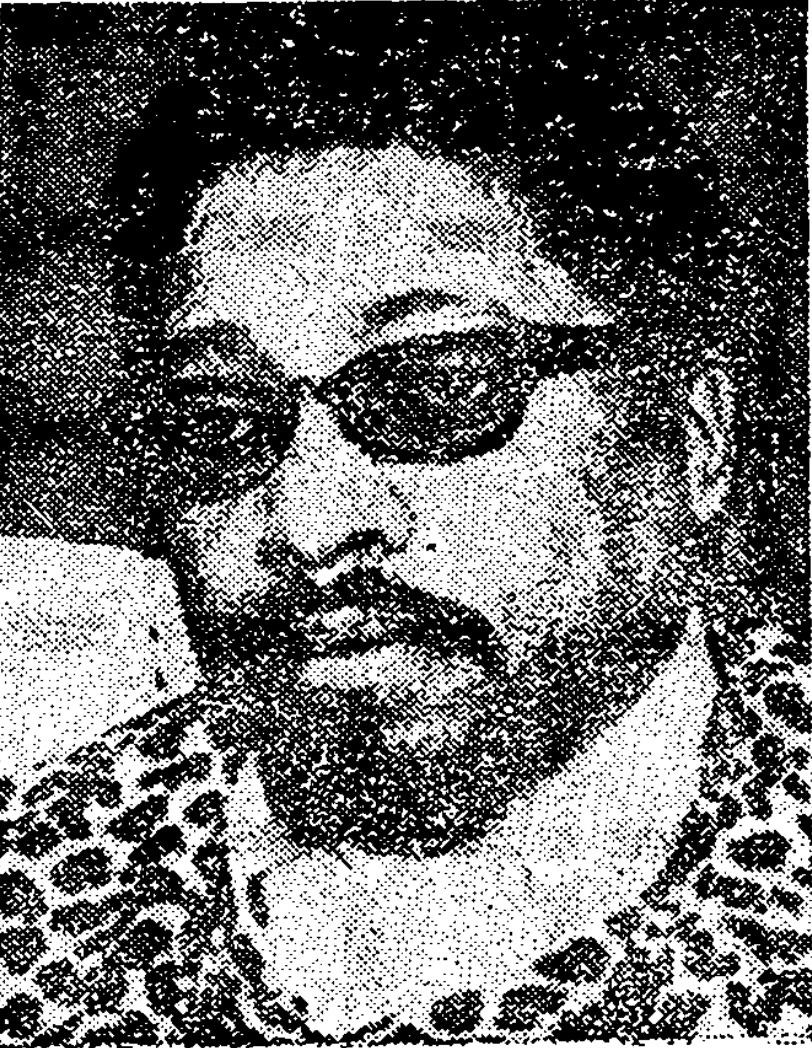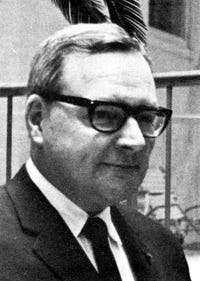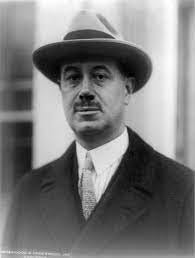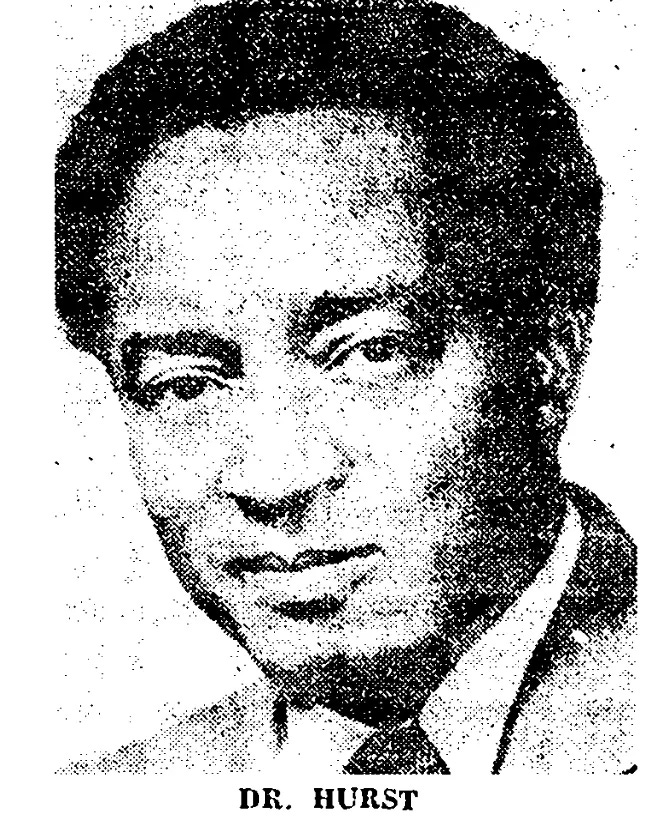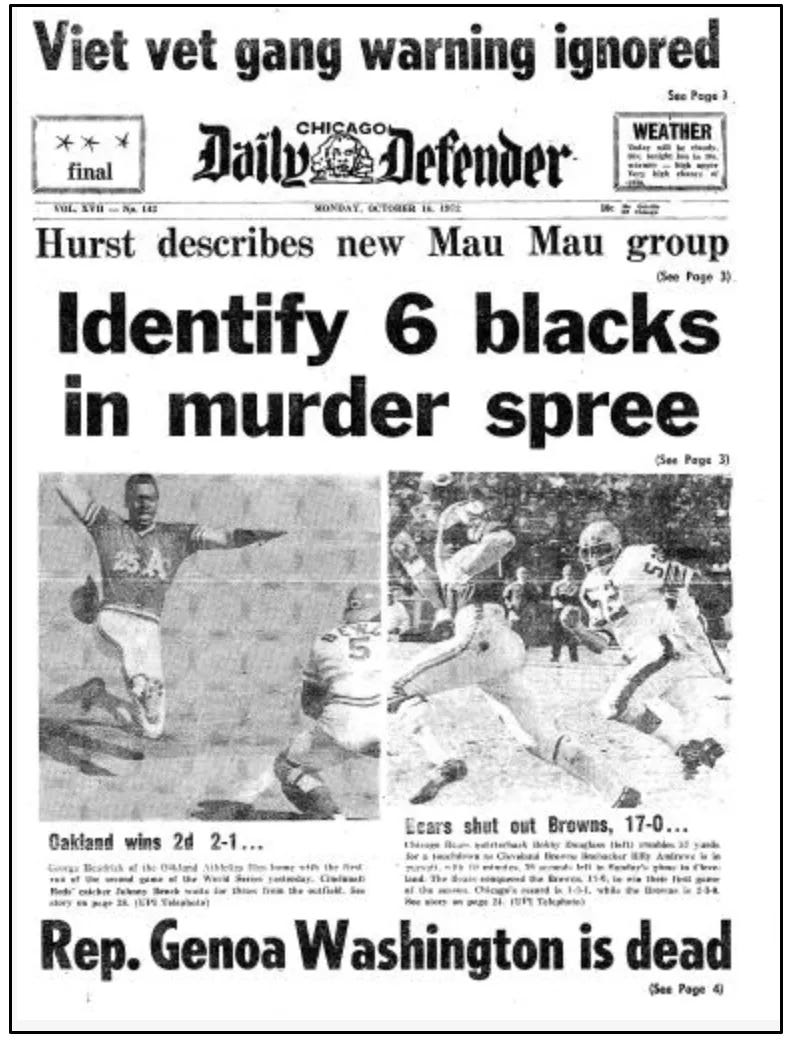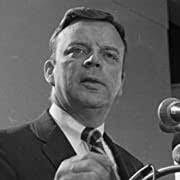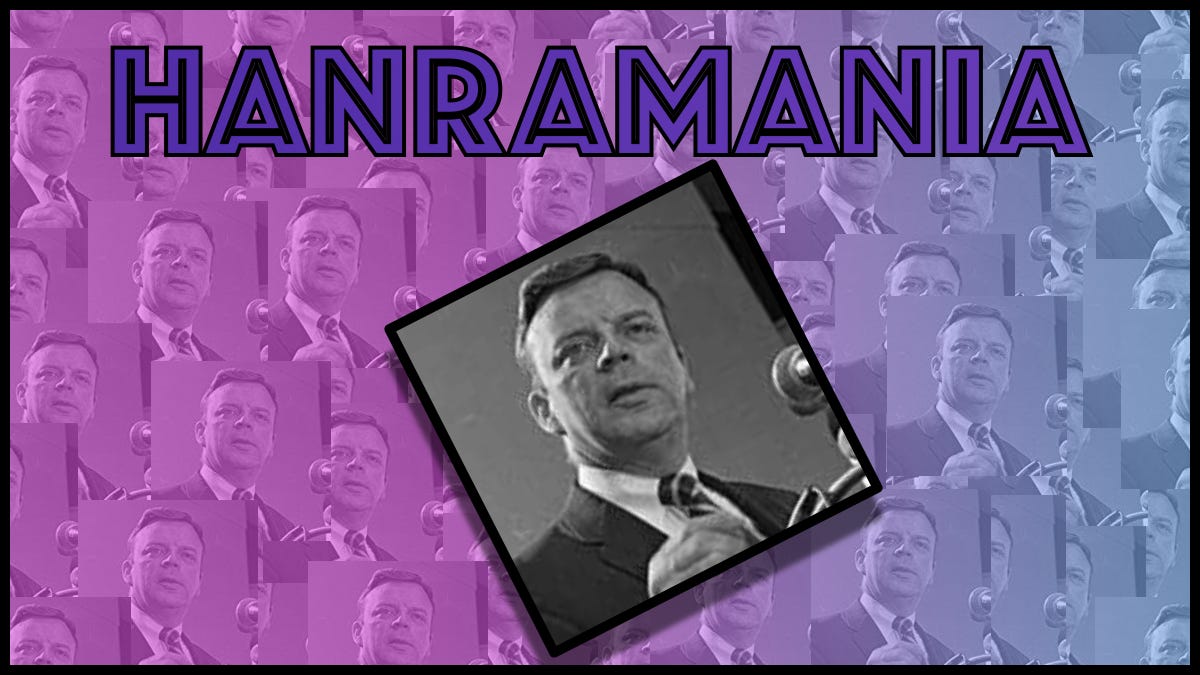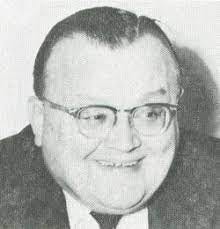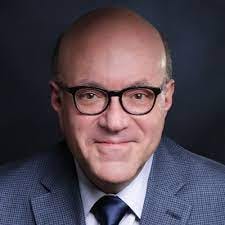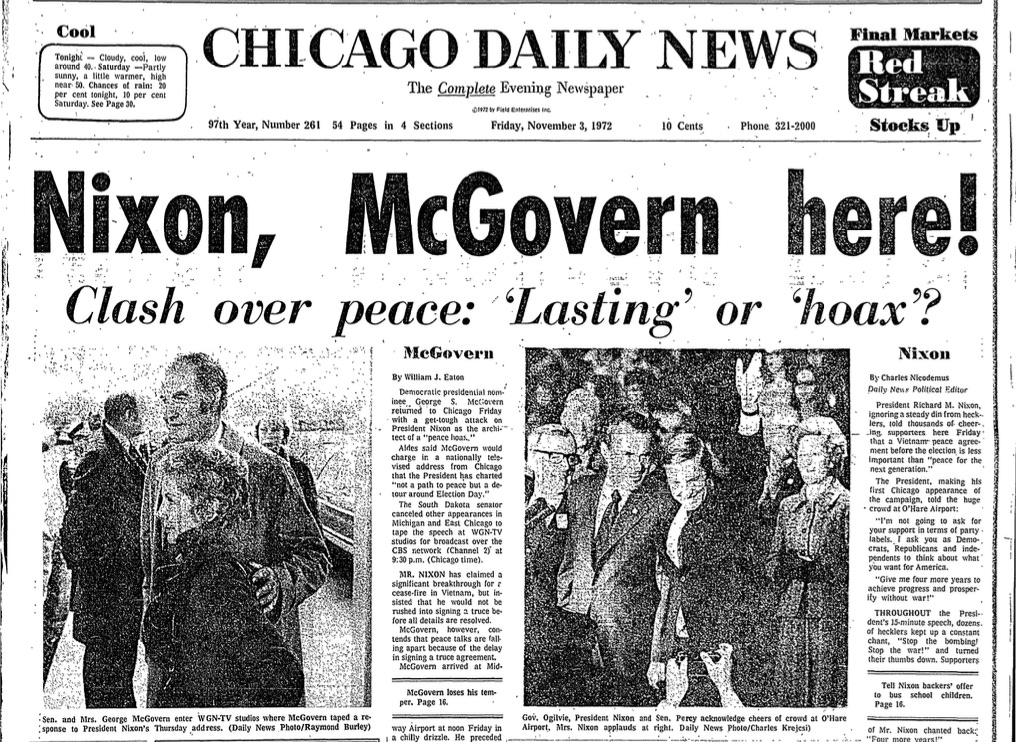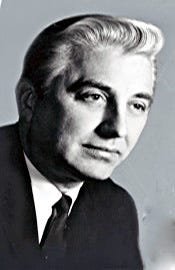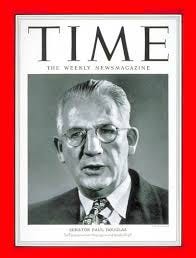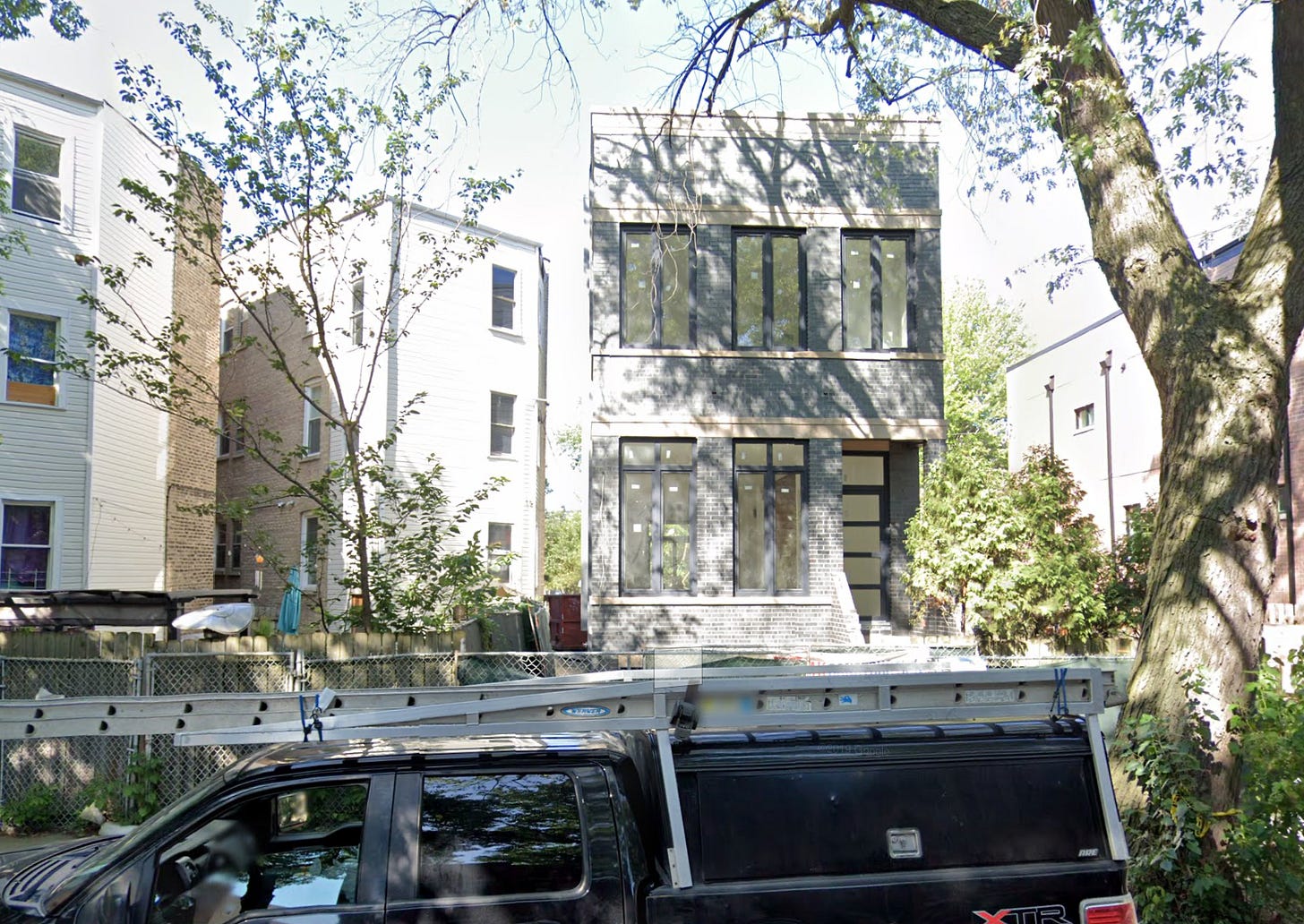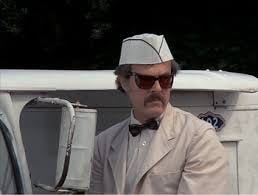THIS CRAZY DAY IN 1972: Election Daze
October 30-November 5, 1972 Addendum
To access all website contents, click HERE.
Why do we run this separate item peeking into newspapers from 1972? Because 1972 is part of the ancient times when everybody read a paper. Everybody, everybody, everybody. Even kids. So Steve Bertolucci, the 10-year-old hero of the novel serialized at this Substack, read the paper too—sometimes just to have something to do. These are some of the stories he read. Follow THIS CRAZY DAY on Twitter: @RoselandChi1972.
This week in 1972 was dominated by the tragic crash of two Illinois Central commuter trains, which killed 44 Chicagoans and injured over 300. See THIS CRAZY DAY IN 1972: Death Train for more.
But other things did happen. In particular, this week is the lead-up to November 7, so we’re doing a TCD1972 Addendum right away to cover the last minute campaigning ahead of Election Day. Readers will have to wait a little longer to find out if President Nixon wins re-election. Oh—and we’ll sprinkle a few non-political treats over the politics along the way.
First, a look at what the Daily News last week called…
Nixon’s Illinois campaign manager claimed they expected up to a million people at Tuesday’s presidential parade, but insisted they weren’t trying to upstage the then-traditional Democratic torchlight parade through downtown for that party’s presidential candidate on Wednesday night.
The McGovern campaign response: “We can out battle Mr. Nixon as far as parades go any time. Mayor Richard J. Daley expects 300,000 people to view the torchlight parade Wednesday night. We think that’s a modest estimate.”
MONDAY
October 30, 1972
Chicago Today
no byline
“The importance of Illinois in President Nixon’s reelection campaign will be reemphasized tomorrow when the President and Mrs. Nixon visit Chicago,” writes Today in a lede they must have taken straight from the Nixon campaign press release.
“With the Nov. 7 election only eight days away, the visit here and a trip to California are the only campaign appearances on the President’s schedule.”
Nixon finally campaigned through New York, Ohio, Michigan, Kentucky, and West Virginia last week, after previously sending his wife, daughters and son-in-law to campaign in his stead. Some presidential rallies drew unwelcome anti-war hecklers, and Nixon did not react well. Nixon ended the week with a 15-minute radio speech featuring his firm anti-amnesty stance for Vietnam draft resisters, which everybody took as a big middle finger to the protesters.
“The highlight of Nixon’s visit will be a ticker tape parade up LaSalle Street, which is expected to draw thousands of supporters from thruout* the Chicago area,” per Chicago Today, despite the Nixon campaign’s earlier claims of one million.
The Tuesday parade up La Salle, from Jackson to Wacker, starts at 11:30 AM “with forward units featuring five marching bands and car-loads of entertainers, sports stars and other notables,” followed by President and Mrs. Nixon in the presidential limousine.
The expected celebrities are underwhelming, judging from the top names here: Dennis Day, Virginia Mayo and Caesar Romero—all stars whose mild heydays were the 1940s and ‘50s. To be fair, Caesar Romero also had a great run as the Joker in the 1960s Batman TV series. Romero is the real attraction in 1972. But will his fans recognize him out of make-up?
However, the Cub players participating include Rick Monday and Milt Pappas, big names in the 1972 Cub pantheon. Per Steve, these days nobody ever gets tired arguing about Milt Pappas’ almost-perfect game.
October 30, 1972
Chicago Daily Defender
no byline
“A blending of the old and the new with more pep and verve than has ever marked a political parade in the history of Chicago!” opens the Defender, in what has to be a souped-up version of whatever the McGovern campaign cranked out.
“The accepted Leader in the presentations which marked the climax of the Roosevelt-Truman-Kennedy-Johnson campaigns is a fit description of the Cavalcade of Lights which will form the setting for George McGovern as he parades the Route of Champions on Wednesday night, November 1.”
I love the 1930’s news reel verbiage the Defender indulges in here, so let’s stay with direct quotes:
“From the Assembly Area north of Wacker Drive, there will move south on the Great White Way of State Street, the legion of McGovern supporters who are merging on Chicago from all over the Midwest to join the Chicago Democratic Forces augmented by thousands of marchers from the Labor organizations, Senior Citizens, the Ethnic and Youth Groups who have rallied to the support of McGovern.
“Bands and Drum and Bugle Corps by the score, floats in greater number than have ever been seen in a parade in Chicago—the home of parades—will take their assigned places in the colorful cavalcade.
“Imported from France, thousands of the torches which have lighted the ski slopes of Europe, every red and green torch which can be found on the United States market will help brighten the already illuminated parade route.”
The parade will head south on State to Jackson, turn east to Michigan, then south to the Auditorium, where McGovern will mount a platform to address “the crowds which will surround the Auditorium.” Then McGovern heads inside to deliver “what will probably be the major address of his campaign.”
Click here to hop over the Chicago History Rabbit Hole and go directly to more 1972 coverage.
Chicago Democratic Torchlight Parades
The papers term the upcoming Democratic torchlight parade for presidential candidate George McGovern as “traditional,” which will surprise many readers by 2022. Above, the Defender writes that a Democratic torchlight parade “marked the climax of the Roosevelt-Truman-Kennedy-Johnson campaigns”.
Hm. Really? And isn’t somebody missing from that list? What happened to Adlai Stevenson (twice) and Hubert Humphrey, just four years ago in 1968?
Or does Mayor Daley decide in advance who’s going to lose, and then skip the torchlight parade?

The answer is: Mayor Daley, alas, did not have supernatural knowledge allowing him to skip the torchlight parade for future losers. Adlai Stevenson got his parades in ‘52 and ‘56, and Humphrey got his in ‘68. However, the tradition doesn’t entirely cover FDR.
FDR didn’t come here for a torchlight parade before his first 1932 win—though he did create a new tradition by flying to the Democratic National Convention in Chicago to accept his nomination. Many readers will recall that FDR’s first win was notable for Chicago in another way: Chicago Mayor Anton Cermak was killed when he spontaneously met up with FDR in Miami before FDR’s inauguration, and took an assassin’s bullet meant for the president-elect as they both sat in a convertible.
There is an awful photo of poor Mayor Cermak being helped away from the car after being shot, clearly in shock. It’s easily found online, but I don’t even want to use it. The photo isn’t at all gory. It’s just the look on his face.
The inaugural torchlight parade took place in 1936, for FDR’s first re-election campaign, ending with a speech at the Chicago Stadium before an estimated crowd of 25,000. The event wasn’t specifically framed as a “torchlight parade” at the time.
The Tribune: “It was the climax of a demonstration with red fire and fireworks in which a great throng of marchers paraded from Grant park through Madison street to the Stadium. Loop traffic was paralyzed. At the Stadium, amplifiers carried the President’s utterances to 15,000 more outside the hall, while along Madison street sound trucks with radio attachments took the speech to other groups.” [Note: The Tribune’s style at that time didn’t capitalize “park” in “Grant Park” or “street” for “Madison Street.”]
The Tribune described the nascent Democratic Machine onstage: “Democratic officialdom was out in full force on the stage. Pat A. Nash, Democratic national committeeman, opened the meeting. Clayton Smith was chairman, and the President was introduced by Mayor Edward J. Kelly, as the ‘greatest president America has ever known.’”
A rally for FDR was held in 1940 at the Stadium, and in 1944 at the Coliseum, both times with New York Mayor Fiorello LaGuardia as the main speaker—but no torchlight parade, and no Roosevelt. BTW, torchlight parades were popular nationally at the time. If you search a newspaper database in October or November of presidential election years through the first half of the 20th century, you’ll see at least several torchlight parades mentioned here and there, in small towns and large cities, and for both parties.
Now, just for fun, a few picture from the traditional Democratic torchlight events mostly via the Tribune. Until 1972, the torchlight parade always ended up at the Chicago Stadium for the big rally and speech.
1948 - Harry Truman
Since the Tribune will famously run a headline proclaiming Truman’s Republican opponent the winner of the 1948 election, it’s perhaps not surprising that the Tribune didn’t bother sending a photographer for Truman’s parade and speech. Even the Daily News ran just this photo of Truman’s wife and daughter.
Plus, the Truman coverage was all on page six, despite the size of the event. Per the Daily News: “Chicago’s Democratic machine gave a spectacular pat-on-the-back to President Truman Monday night with a torchlight parade, bands, bombs and fireworks. Some 400,000 persons, police estimated, were spectators or marchers in the procession of the party chief through the Loop to the Chicago Stadium.”
But, the Daily News claimed, there was relatively little enthusiasm. Truman drove to the Stadium in an open car, starting from the Blackstone Hotel with then-Mayor Martin Kennelly and ex-Mayor Ed Kelly. “But momentarily, Mr. Truman had to share public interest with a man perched on a third-story ledge, who had everybody wondering how soon he’d fall.”
Truman didn’t even make the Daily News front page.
And under that headline, the Daily News ran this big picture in the center of the front page:
Admittedly, the Daily News did give Truman the front page and a picture for his arrival in town in the previous day’s edition:
1952 - Adlai Stevenson
1956 - Adlai Stevenson
1960 - JFK
Note the three giant faces onstage, left to right: Mayor Daley, JFK, and VP LBJ.
1964 - LBJ
The big faces across the stage, left to right, are Mayor Daley, LBJ, VP Hubert Humphrey, and Illinois Gov. Otto Kerner.
1968 - Hubert Humphrey
A much more restrained affair, the Trib only ran this single picture below.
Here’s the headline, covering the issue most readers cared about at this point in the 1968 election season:
When did the glorious Democratic torchlight parade end? Michael Dukakis was the last candidate to get the torchlight treatment in 1988. Cook County President George Dunne really pushed for the Dukakis parade, hoping it could give the Democratic presidential candidate a last-minute boost. Nope. Perhaps it was Dukakis’s ultimate failure that snuffed out the torches for good.
In between McGovern and Dukakis: Candidate Jimmy Carter didn’t get any rally or parade in 1976, but President Carter got a rally in Daley Plaza in 1980—after Mayor Jane Byrne pronounced the traditional torchlight parade “a bit passe.” The Democrats returned to the torches for Walter Mondale in 1984, and then that one last time for Dukakis in 1988.
That was it—no announcement, just no more torches.
October 30, 1972
Chicago Sun-Times: How Can You Vote for Nixon?
Political TV ads were well established by the ‘60s—we all know the 1964 “Daisy Girl” ad convinced voters that Barry Goldwater would get them blown up in a thermonuclear war, right? Goldwater was actually already losing to LBJ before Daisy Girl, and the ad only ran once. But Daisy Girl is nonetheless such a touchstone, it shows you quite viscerally that TV political ads were old hat by 1972.
My point is that despite the rise of TV political spots, print ads were still a major player in 1972. Probably no 2022 readers will remember print ads from the 2020 presidential election. Or the one before that, and so on. But this week’s TCD is stuffed with full-page campaign ads vying for voters’ attention.
It’s also interesting to see where ads are placed. This one, for instance, I only saw in the Sun-Times. Later, we’ll see ads placed specifically in both the Defender and the Sun-Times, backing up the common wisdom that the Sun-Times had the largest Black readership among the major dailies.
October 30, 1972
Chicago Today: Nixon letter
Michael G. Thoren: Oh snap!
Don’t miss Mike Royko 50 Years Ago Today
TUESDAY
October 31, 1972
Chicago Today
by Joel Weisman, political editor
So much for the predicted parade war, Mayor Daley and George McGovern duking it out with President and Mrs. Nixon.
“In deference to the Illinois Central commuter train tragedy, President Nixon has canceled today’s planned Loop parade and Sen. George S. McGovern and Democratic leaders here have postponed the traditional torchlight parade scheduled for tomorrow evening.
“And tho* the election is only a week away, most politicians observed an unofficial temporary moratorium on partisan rhetoric.”
Nixon and McGovern issued statements of condolence.
At the gubernatorial level, Gov. Richard Ogilvie ordered the Illinois Commerce Commission to investigate “so tragedies like this can be prevented in the future.” His Democratic opponent, Dan Walker, canceled a political speech at the City Club, and acknowledged that Ogilvie sincerely wanted to “find out what happened.” That was apparently necessary, given the nasty debate between the two—we’ll cover that in the next go ‘round of 1972.
U.S. Sen. Charles Percy visited the IC crash scene and called for federal laws to require seat belts on trains, since many victims were injured by being flung across the train cars. His Democratic opponent, U. S. Rep. Roman Pucinski, planned to ask for a Congressional investigation and called the new IC double-decker cars “an aluminum death trap on wheels.”
October 31, 1972
Chicago Sun-Times: All in the Family
by Irving Wallace - Special to the Sun-Times
“Well, it has happened,” writes novelist Irving Wallace for the Sun-Times. “You can throw out the Gallup and Harris polls. The voice of Middle America, long muted, has finally spoken out.
“Archie Bunker has made up his mind who he is going to vote for in the presidential contest.
“Persistently wooed by President Nixon’s big-game persuaders and Sen. George McGovern’s passionate supporters, Archie refused to answer his phone or open his door to either side for weeks. He told them to stifle it….This week he made up his mind. Archie Bunker is casting his vote for McGovern.
“So are his wife Edith Bunker and his daughter Gloria and his son-in-law Mike. It will astonish millions of people to know that for the first time Archie and his son-in-law are on the same side and in total agreement.”
Well, not quite. The lead actors from America’s #1 television show, “All in the Family,” are voting for McGovern. Actors Carroll O’Connor (Archie) and Rob Reiner (Mike Stivic) will make campaign appearances for McGovern, and O’Connor is taping McGovern commercials.
Everybody understands the power of having Carroll O’Connor come out publicly for a political candidate. Everybody knows it’s tantamount to a real live Archie Bunker endorsement, which both sides would covet. Which, given that Archie is always shown to be wrong by the end of any episode of “All in the Family,” doesn’t really make sense. But there you are.
So Carroll O’Connor tells Irving Wallace that he hesitated to make any public choice at all, not wanting to potentially upset fans. Irving Wallace repeats that Nixon and McGovern forces eagerly courted O’Connor’s vote, claiming that “several big names in the movie industry, powerful names who were friends of Mr. Nixon’s, made a major effort to get O’Connor to come over to the President.
“They felt that by getting O’Connor they would get the Archie Bunker image to reach millions of Americans who have Bunker in their homes every Saturday night and who love him and are influenced by him.
“The Nixon people wanted to use O’Connor as Archie Bunker on television and radio spots and in ads. They wanted to paper the country just before the election with photos of Mr. Nixon and Archie Bunker shaking hands.”
The Nixon forces will have to settle for Sammy Davis Jr. They should have gone for some political transference by running side-by-side pictures of the iconic February 1972 “All in the Family” episode when Sammy kisses Archie, and the infamous picture of Sammy hugging Nixon at a concert held during the recent Republican National Convention.
The McGovern people courted Archie too. Carroll O’Connor tells Wallace, in a five-hour conversation at the home of “All in the Family” creator Norman Lear, that he asked the McGovern people hard questions, mostly about the Vietnam War. He came out satisfied:
“I felt McGovern was an honest man who was committed to peace, not only in Indochina,” O’Connor tells Wallace. But Nixon broke his 1968 campaign promise to end the war. “Getting our ground troops out of Vietnam does not mean ending the war in Vietnam. Nixon beefed up our Air Force so that for nearly four years innocent people have been bombed and napalmed to death.”
BTW, Younger Readers are probably tired of hearing this, but it is difficult to impress on those who grew up after the explosion of viewing options, and subsequent fragmentation of the national audience, how different the impact was of a #1 show in 1972, versus 2022. In 2022, it’s not just possible but likely that the average person doesn’t know 90% of the people considered “famous.” But in 1972, nobody did not know Archie Bunker.
“All in the Family” was also the big winner at 1972’s Emmy’s, winning six awards, including best comedy series, best comedy actor for O’Connor, best comedy actress for Jean Stapleton (Edith Bunker) and best supporting actress for Sally Struthers (Gloria). Rob Reiner should have won as Meathead, too.
Note: Irving Wallace, a best-selling 20th century author incidentally born in Chicago, wrote some fun dispatches for the Sun-Times from the Democratic and Republican national conventions, which we’ll use in a future TCD addendum.
Earlier this year, the movie version of Irving’s 1963 novel “The Man” came out, starring James Earl Jones as a Black U.S. senator who is president pro tempore of the Senate and becomes president after a series of unfortunate events makes him next in line for the vacated seat. See here for Gene Siskel’s four star review.
October 31, 1972
Chicago Daily Defender: Letter to the editor
Ruth Bergman doesn’t understand why the Watergate disclosures aren’t stirring more voter outrage. She’s not the only one, but I was struck by her eloquent message, and her historical examples, which I haven’t seen mentioned elsewhere.
How many of you really know what a “vicuna coat” is? You can get them for as little as $1,000-$2,000 in 2022, but I also see some listed for $23,000-$33,000.
Here’s President Eisenhower saying he’ll keep Sherman Adams despite the vicuna coat scandal.
October 31, 1972
Chicago Daily Defender & Chicago Sun-Times: Sen. Richard Newhouse
This is an election season where party is not a reliable indicator of who anyone is supporting. As we’ve seen, there are Democrats for Nixon…Republicans for McGovern…
…and Black voters for Nixon.
Here, Illinois Senator Richard Newhouse shows he is a Black Democrat for a different Republican—incumbent Illinois Governor Richard Ogilvie, who’s in a tight race against upstart independent Democrat Dan Walker.
There will be more on this as the week progresses.
For now, note the stripe of instructions between the ad copy on top and the donation coupon at the bottom:
These instructions show vividly why everybody has been in a tizzy about whether to encourage voters to “split the ticket” rather than pulling the lever to vote a straight Democratic ticket. Many furious Chicago Democratic Ward Committeemen and precinct captains would like to tell their voters to pick Republican President Richard Nixon instead of Democratic opponent Sen. George McGovern, because McGovern let the national convention kick Mayor Daley and his elected slate of delegates out, in favor of an independent delegation led by Ald. Bill Singer and Rev. Jesse Jackson.
But holy moly, look at that stripe of instructions above, telling voters how to vote a straight Democratic ticket while also voting for Republican incumbent Gov. Richard Ogilvie.
The 1972 voting machines were not nearly as simple as later Chicago ballot methods. By the 1980s, Chicagoans punched little holes out of the ballots with a pen-like instrument, choosing the hole next to a preferred candidate’s name. Later they drew a line with a black magic marker in the right spot for each chosen candidate. But the old voting machines were something else entirely. I never used one, and I admit that until I saw the instructions in this ad, I did not fully grasp why it was such a big deal to tell voters to do anything other than pull the straight party lever.
Consider how many people you know in 2022 who can’t click on a link in an email. Then imagine them following the instructions in this ad, correctly.
Did you miss that nutty Democratic National Convention? It’s right here.
WEDNESDAY
November 1, 1972
Chicago Sun-Times: Charles Moore kidnapping update
Remember the dramatic kidnapping in August of South Side businessman Charles Moore? Update today in the Sun-Times, no byline.
Moore was abducted from the parking lot across the street from the offices of Charles Moore Construction & Realty Co. at 352 E. 87th St., then tied up and blindfolded at this house overnight. See link for full details, but the kidnappers asked Moore’s wife to withdraw $15,000 from the bank, then leave it in a brown paper bag at the corner of 81st and Ingleside. A guy walking his dog found the bag of money. He “turned it into the FBI”.
See the original post for full details, but the kidnappers asked Moore’s wife to withdraw $15,000 from the bank, then leave it in a brown paper bag at the corner of 81st and Ingleside. A guy walking his dog found the bag of money. He “turned it into the FBI”.
A fifth suspect is still at large. And, sadly, no details on who these people are, or why they targeted Charles Moore.
THURSDAY
November 2, 1972
Chicago Daily Defender: Sen. Richard Newhouse
by Robert McClory
“An embarrassed and angry state Sen. Richard H. Newhouse (D-24) Wednesday vigorously denied that he intended ‘in any way’ to support the re-election of State’s Attorney Edward V. Hanrahan” via the full-page political ad that ran in Tuesday’s Defender and Sun-Times, a few items above. Here it is again:
Remember those complicated instructions on how to vote the straight Democratic ticket, but also vote for incumbent Republican Gov. Richard Ogilvie?
“It included a six-step chart, showing Democratic voters how to split their ticket,” writes the Defender’s Robert McClory. “But anyone who followed the suggested steps to the letter would automatically cast a vote for” Cook County State’s Attorney Ed Hanrahan, who was acquitted on October 25 of conspiracy to obstruct the investigation into his office’s predawn 1969 raid on a Black Panther apartment which killed Fred Hampton and Mark Clark.
If you need a Hanrahan refresher course, here’s the Hanrahan primer.
“Several indignant inquiries have been received by the Daily Defender since Tuesday, asking if Newhouse and those who support his candidacy are subtly urging blacks to elect the controversial Hanrahan,” per McClory.
“‘My God, no,’ said Newhouse. ‘The chart was a mistake, and I have to take full responsibility for it. We were trying to show traditional straight Democratic voters how to pick candidates from the other party. We never meant to imply endorsement of Hanrahan. If I could do it over again, I’d certainly change that ad.”
Newhouse tells McClory that his campaign is on a tight budget and schedule, “causing occasional oversights.” But he will run another ad in the Defender specifically against Hanrahan.
Tuesday’s Newhouse ad included the names of 109 prominent Black Chicagoans serving on the Newhouse-Ogilvie Executive Committee. Many of them have also “strongly disavowed any implied endorsement of the state’s attorney,” including “Dr. Herbert Odom, an Englewood dentist; Millard Robbins, president of Robbins Insurance Agency; William Manney, WBEE; and historian Dr. John Hope Franklin, of the University of Chicago”.
Recall that Dr. Odom is a friend of U.S. Rep. Ralph Metcalfe, and it was Odom’s traffic stop by Chicago police on March 13 that instigated Metcalfe’s current crusade against police brutality, and Metcalfe’s break with Mayor Daley’s Democratic Machine. See April 25, May 2, May 3, May 4, and May 6-7 for more details.
At Metcalfe’s official hearings on police brutality in June, Odom “testified that he was abusively stopped and searched by two policemen last March 13 as he drove near 59th St. and S. Union,” Lu Palmer reported in the Daily News. “Odom said he was handcuffed, searched on the street and then pushed into a squad car and taken to a police station, where he was charged with striking an officer and disorderly conduct.”
November 2, 1972
Chicago Today: Ald. Vito Marzullo
by Chris Agrella
Remember we mentioned there are a lot of pissed off Democratic Machine precinct captains and Ward Committeemen who don’t want to vote for George McGovern, and they’d just as soon tell their voters how to split the ticket and vote Democrat but pick Nixon for president?
Meet Ald. Vito Marzullo.
After McGovern let Mayor Daley and his elected delegation get kicked out of the Democratic National Convention in favor of the unelected independent delegation led by Ald. Bill Singer and Rev. Jesse Jackson, Marzullo told every reporter who’d listen that he would not vote for McGovern.
Here’s Marzullo disrupting one of the Singer-Jackson delegate meetings to choose their own slate back in June. When the poor guy leading that meeting said he’d adjourn somewhere else to get away from the regular Democrats and their bullhorns, Marzullo yelled, “We’ll follow you to the graveyard.”
After the debacle of the Democratic convention, Mayor Daley finally emerged from a mysterious disappearance from public view and held his first press conference on July 17. Reporters peppered Daley with questions, including:
“Ald. (Vito) Marzullo says he won’t support McGovern.”
From Sun-Times columnist Tom Fitzpatrick’s terrific column on the press conference:
“His [Mayor Daley’s] final answer is directed at the questioner who said Marzullo is not going to support the Democratic ticket.
“‘Ald. Marzullo is a fine Democrat,’ Daley says. ‘This is only July. Why don’t you wait until November?’”
Well, now it’s November.
“Ald. Vito Marzullo, Democratic Party boss of the Near West Side 25th Ward, long has threatened to urge his constituents to vote Republican on November 7,” opens Chicago Today’s Chris Agrella in today’s paper.
“And he’s true to his word: Marzullo has begun campaigning for the reelection of President Nixon and Gov. Ogilvie.
“The scrappy 75-year-old alderman is miffed because the Daley delegation—including Marzullo—were ousted in July as delegates to the Democratic National Convention in Miami. He blames George McGovern, Democratic Presidential candidate, for the affront.”
Marzullo also doesn’t back independent upstart Democrat Dan Walker, running against Republican Gov. Richard Ogilvie after beating Machine candidate Paul Simon, then Lt. Governor, in the primary.
“To back his drive for the two top Republicans, Marzullo has passed out 30,000 cards to his precinct captains and ward residents, showing just how they should split their vote on Nov. 7.
“The card, about 8 by 4 1/2 inches, depicts a voting machine with the top six candidates in the G.O.P. and Democratic slates.”
“‘I expect to carry my ward for Nixon and Ogilvie,’ Marzullo boasted in his City Hall office yesterday. He was sporting a set of cuff links bearing the Presidential seal, which he said were sent to him by the President.”
Marzullo met Pat Nixon when she came to Chicago for the Columbus Day parade in October.
“He reportedly told the First Lady: ‘I come from a strong Democratic ward and I can’t say I’m going to carry it for the President, but if I can, I will.’
“In the last mayoral election in April, 1971, Marzullo’s ward gave Mayor Daley 14,599 votes and 2,177 to his opponent, Richard Friedman.”
November 2, 1972
Chicago Daily Defender
no byline
“Four black members of the Illinois House of Representatives blasted Republican Governor Ogilvie for ‘false, distorted and misleading information directed toward the black community,’ at a special news conference chaired by Rep. Corneal A. Davis of the 2nd District.”
Davis, along with Rep. Harold Washington, Lewis Caldwell and Eugene Barnet, charged that Ogilvie’s campaign was “an insult to the dignity and pride of all people—black, brown and white” and meant to “pervert the will of the people in this crucial 1972 election.”
Per a written statement, these four representatives condemned Ogilvie for vetoing a bill to provide school breakfasts and lunches for needy children, reducing a college scholarship program for needy students by $3 million ($20 million in 2022 money), and “doing nothing about constantly rising unemployment, which is 60 percent higher in Chicago’s black community than it was 4 years ago.”
November 2, 1972
Chicago Daily Defender: Russ Meek
no byline
Russ Meek, a West Side civil rights activist who heads Search for Truth, Inc., has become so prominent in the news this year that the Defender devotes an entire article today to Meek’s voting picks in next week’s election.
So a quick Russ Meek recap: Meek hit the papers this year initially as the person who first pushed the newspapers to cover the growing number of West Side Black men who disappeared, then turned up murdered and dumped in the Sanitary and Ship Canal or the South Branch of the Chicago River.
Those murders turned into the sensational police Hit Squad case which broke in late June. After an FBI investigation, five Black policemen were initially accused of executing eight West Side men as part of a narcotics ring. But they weren’t arrested. So far, only one cop has actually been charged with anything—Sgt. Stanley Robinson, who disappeared after faking his own kidnapping. Robinson later surrendered, and for now is only being charged for his staged kidnapping. Meek immediately insisted the Hit Squad murders would include many more cops—specifically white cops.
Meek has also been prominent in U.S. Rep. Ralph Metcalfe’s drive against police brutality in the Black community, which began in May. As 1972 went on, Meek became a go-to Black leader for quotes on Black issues in both the Defender and the major dailies.
Meek was quoted on the tragic murders of young Rodney Harris and Lawrence Green in late August. He believed both murders were part of the Hit Squad scandal and called them “part of a conspiracy to kill blacks.” (Green, it would quickly turn out, was murdered by his wife. Rodney Harris’ murder is not going to be solved.)
Today’s article begins with Meek’s picks:
President: George McGovern (Democrat)
U.S. Congress: Ralph Metcalfe and George Collins (Democrats)
States’ Attorney: Bernard Carey (Republican)
U.S. Senator: Charles Percy (Republican)
State Representative: Harold Washington and Lewis Caldwell (Democrats)
City Council: Clifford Kelly and Tyrone Kenner (Democrats)
It’s interesting that Meek is voting for so many Republicans, since he’s otherwise an enemy of Malcolm X College President Dr. Charles Hurst, strongly advocates for Blacks to vote Republican.
“My choices were made only after a period of agonizing reapproval [sic] occasioned by the seriousness of the times,” Meek said in a written statement. “We, as Black people cannot live with the Stop and Frisk Law, and any official who upholds it or administers it is participating in genocide of Black people.”
“Meek said that since Gov. Richard Ogilvie came out for the Stop and Frisk Law, any Black person who votes for him is committing an act of ‘suicide,’ pure and simple.”
Also, Meek wrote that “Republican money” made “Benedict Arnolds of many of our brothers and sisters. When the election is over and we reflect on the events of this Summer and Fall, we will realize that these Xxxxxxx for Nixon were never really Black, but just pretenders out for personal gain and self-aggrandizement…and the black tides of history will diminish them to ignominious oblivion, and their footsteps will never be in the sands of time.”
November 2, 1972
Chicago Tribune: Democrats help Ogilvie
George Tagge, the Tribune’s political editor from 1943 to 1972, was notorious for participating in the news rather than just reporting it. Many people believed Tagge “ran the Illinois Republican Party under the auspices of his Tribune position,” as Tribune political reporter and managing editor Richard Ciccone wrote in his Mike Royko biography, “A Life In Print.”
Tagge is credited with practically writing the state legislation that let Chicago build McCormick Place, and name it McCormick Place for Tagge’s then-boss, Tribune owner and publisher Col. McCormick. That’s why it was originally tagged “Tagge’s Temple.”
This is a pretty straightforward article, but we can be sure the Tribune is happy to give any publicity to Democrats backing Republican Gov. Richard Ogilvie.
“Prominent independent Democrats yesterday began a blitz in [sic] behalf of Republican Gov. Ogilvie as part of a new barrage of endorsements for his reelection Tuesday,” writes Tagge.
Tagge is writing specifically about “Independents for Ogilvie.” That group includes State Sen. Richard Newhouse, but is separate from the Newhouse-Ogilvie Committee. “Independents for Ogilvie” is chaired by former Better Government Association president John White, and also includes prominent Chicago names like the University of Chicago’s Julian Levi.
Here’s the full-page ad that Independents for Ogilvie will run on November 3 in the Sun-Times:
“A total of 423 mayors have enlisted in the Ogilvie campaign, including the mayor of Deerfield, home of Dan Walker,” Tagge reports, without specifying if these mayors are all Democrats.
“The Athletes for Ogilvie Committee has recruited Dick Butkus of the Bears and Randy Hundley of the Cubs as co-chairmen, and a long list of other present or former athletes.”
November 2, 1972
Chicago Sun-Times: Dr. Charles Hurst
by Ellis Cose
Malcom X College President Dr. Charles Hurst held a “worker’s rally” on Wednesday night at the college for about 500 people, sponsored by his own community group, People Organized for Work, Equality and Representation, along with Students to Stop Hanrahan.
Hurst “bitterly denounced the Democrats and State’s Atty. Edward V. Hanrahan…and asked blacks to vote a straight Republican ticket,” writes the Sun-Times’ Ellis Cose.
“Hurst denounced Hanrahan and Sheriff Richard J. Elrod as ‘a merciless prosecutor and a sheriff without a conscience’ who used the De Mau Mau disclosures politically.”
Hanrahan and Elrod held an unprecedented weekend press conference on October 15 announcing that brutal area slayings—including the mass slaughter of the Corbett family in Barrington Hills and the Hawtree family in Monee—were all perpetrated by a group of eight Black Vietnam veterans belonging to a group calling itself “De Mau Mau,” which targets white victims.
The De Mau Mau case flared in giant headlines for several days, then all but disappeared after intense push back from Black leaders over the coverage. For a full rundown, see the introduction to Mike Royko’s October 16 column on the topic or scroll through that week’s TCD1972, reading the daily coverage under the De Mau Mau heading.
While the arrests of the initial De Mau Mau suspects have so far held up at this date, everyone quickly agreed there was no 3,000-strong army of Black Vietnam veterans stalking white Americans. The papers muted follow-up stories as the case continued, mostly avoiding use of the term “De Mau Mau” altogether.
But we should note that Dr. Hurst came under fire himself for his initial remarks to reporters after the Hanrahan-Elrod press conference. Four of the De Mau Mau suspects had been Malcolm X College students.
Hurst told reporters that those four De Mau Mau suspects had threatened students on campus until they were expelled in spring 1972, and their elaborate ritual handshake was barred from campus.
“It was pure terror,” the Defender quoted Hurst. “Members of the Mau Mau would intimidate and beat up students and teachers.” Hurst said he didn’t think the Mau Maus were political, and didn’t believe their alleged crimes were racial. “It was just plain hatred,” he said.
A day later, Hurst held a press conference with Barry Wright, head of Concerned Veterans From Vietnam, and denied there had any been any De Mau Mau presence on his campus. Hurst said the suspects had been expelled for bad grades and attendance. There was never any explanation for the difference between Hurst’s initial and later comments.
Hurst and Barry Wright contended that Elrod and Hanrahan were creating “sensationalism to spur their political careers.” Hurst said Hanrahan was “trying to stir up a white backlash that will ensure his re-election.”
Back to Wednesday night’s rally:
“Hurst told the audience that the black community must defeat Hanrahan or he will be the State’s Attorney for four more years and will succeed Richard Daley as mayor of Chicago.
“He also charged that ‘the Democratic Party is the party of the bigots of the South who have been running this country all along.
“‘Smash the Democratic Party to the point it will never be the same,’ he urged.”
Cose also quotes another speaker, William H. Robinson, the state director of registration and education, appointed by Gov. Ogilvie: “If blacks allow Hanrahan to be re-elected, he said, ‘we ought to cut off our naturals…and stop talking about being black.’”
“‘The only way to beat Hanrahan is to stay away from the big lever A,’ said Robinson, referring to the voting machine lever which registers a straight Democratic vote.
“‘It’s poison,’ he said. ‘It’s evil, it’s destructive….Stay away from it. It’s a plague.’”
November 2, 1972
Chicago Sun-Times: Prudential Building
Don’t miss the hilarious caption.
November 2, 1972
Chicago Today
November 2, 1972
Chicago Daily Defender: Hanrahan’s defense
FRIDAY
November 3, 1972
Chicago Today: New Democrats for Nixon ad
November 3, 1972
Chicago Daily News: Herguth’s People
Today, Bob Herguth starts out by checking in with Chicago icon Sig Sakowicz, who recently moved to Arizona due to health reasons.
For a terrific look at Sig Sakowicz and what he meant to Chicago, see Mike Royko’s October 6 column, “Sig Sakowicz says goodbye”—and then scroll down to the Weekend Edition for a Sig Sakowicz scrapbook.
A bit lower in today’s Herguth:
The 16-year-old Bob Feder in today’s Herguth is the iconic Chicago media reporter Robert Feder, who just retired from covering Chicago’s media scene for 42 years, signing off in July 2022. Here’s Neil Steinberg’s peon to Feder in the Sun-Times, Justin Kaufman’s look in Axios, and Eric Zorn’s “Exit Interview” in his Substack, The Picayune Sentinel.
November 3, 1972
Chicago Daily News: W. Clement Stone
by William McGaffin
This story concerns Chicago’s own Simpson’s character, W. Clement Stone, a local Horatio Alger story who started working as a newsboy after his father died, and ended up founding the insurance company that now owns this building at the north end of Grant Park.
In 1972, Stone is Chicago’s top rich Republican. He promised to get Chicago the two pandas that President Nixon was promised after his trip to China earlier this year. Chicago did not get those pandas, but Stone has promised to get two more pandas. Stone is probably undeterred because he is famously obsessed with positive thinking. He wrote “Success Through a Positive Mental Attitude” with Napoleon Hill in 1960. He also founded the group that backed adding “under God” to the Pledge of Allegiance in the 1950s.
“Chicago millionaire W. Clement Stone and his wife have contributed more than $1 million to President Nixon’s re-election campaign,” writes the Daily News’ William McGaffin.
“Republican campaign records made public under court order Thursday night put the Stones’ contribution at $1 million through last March 9. But the Stones obviously have given more money to the campaign since then, for Stone said after the records were made public that ‘as a matter of fact’ the contributions total more than $1 million.
“How much more? He wouldn’t say.”
Stone was the #1 Nixon contributor per these records.
Later, it will be revealed that Stone gave Nixon $10 million in1972, and he gave Nixon $10 million in 1968 too.
This is news because “Republicans refused for months to discuss the names of donors who contributed an estimated $10 million to their campaign war chest before a new law went into effect that made disclosure mandatory.”
Today’s information is a partial disclosure required by an agreement after Common Cause sued the campaign.
November 3, 1972
Chicago Today: Watergate letter
November 3, 1972
Chicago Sun-Times
President Nixon, after canceling his Tuesday ticker tape parade in the Loop due to Monday’s Illinois Central train crash, rescheduled a Chicago stop at O’Hare for noon today…
…and McGovern addressed a rally at the Auditorium Friday night. A much shorter torchlight parade took place, with some torchbearers lining Michigan Avenue from Jackson to Congress.
McGovern continues to attack the waffling peace announcements coming sporadically from the Nixon administration via Henry Kissinger as a “hoax” aimed at getting votes.
Tomorrow, the Daily News will run an account of McGovern’s Friday night speech with this headline:
SATURDAY-SUNDAY
November 4, 1972
Chicago Sun-Times
November 4-5, 1972
Chicago Daily Defender: 2-page ad against Nixon
November 4, 1972
Chicago Tribune & Chicago Today: Letter from former U.S. Senator Paul Douglas
Poor Roman Pucinski. We’ve made a lot of hay, admittedly, out of Pucinski’s suggestion that he wanted to punch Citizen Action Program’s Father Leonard Dubi at an Anti-Crosstown Coalition rally back in April.
Pucinski gets no respect from Mike Royko, that’s for sure. Royko thought Pucinski was a schmuck of a reporter when Pucinski worked for the Sun-Times.
However, here former U.S. Sen. Paul Douglas, the closest thing to a saint in politics…
…warmly endorses Pucinski to win back the Senate seat Douglas lost to Charles Percy six years ago:
This letter ran in the Tribune and Chicago Today. It definitely did not run in the Daily News or the Defender, and I don’t see it in the Sun-Times for the previous two weeks, or next week. Douglas would have sent this letter to all the papers, so it’s interesting that the Field papers both didn’t run it, but the Tribune papers did.
November 4 & 5, 1972
Chicago Sun-Times
Here are the two ads State Sen. Richard Newhouse quickly produced to make up for his October 31 ad that accidentally instructed voters how to vote for Republican Gov. Richard Ogilvie in a method which would cast a vote for Democratic State’s Attorney Ed Hanrahan by default.
But these ads only show voters how to vote a straight Democratic ticket while also voting for Hanrahan’s Republican opponent, Bernard Carey—which leaves Republican Gov. Richard Ogilvie out in the cold.
Chicago Daily Defender
November 4, 1972
Chicago Tribune: Ald. Vito Marzullo goes to court
no byline
A Vito Marzullo double header this week!
Back in September, angry Chicago police who have several demands they’re not getting from Mayor Daley, including the right to bargain over a contract, went on a rogue job action by writing as many tickets as they possibly could.
That got people’s attention! Including Mike Royko. For more, see his September 27 column, and September 28— “Ticketed cabbie plots revenge.”
Ald. Vito Marzullo got hit by the ticket blitz too.
“Ald. Vito Marzullo [25th], colorful veteran of 53 years in Chicago politics, came storming into the City Hall press room yesterday morning,” wrote the Trib’s Edward Schrieber in September.
“Waving his arms in the air, Marzullo, 74, bellowed: ‘I got a parking ticket!’”
Marzullo got the parking ticket he’s holding in the picture above on his big black Cadillac, in front of his home at 832 S. Oakley Blvd. It was a ticket for parking too close to a fire hydrant. Marzullo insisted that he paced the distance between the hydrant and his Cadillac, and it was farther than the legally mandated 15 feet.
Now, the parking tickets issued in September are coming due in Traffic Court.
Today’s installment in Ticketpalooza:
no byline
“Ald. Vito Marzullo usually gets the last word,” reads the lede—but that won’t be the case today in Traffic Court for Marzullo’s ticket blitz citation.
“Marzullo walked up to the bench, and before he said a word, Judge Frank R. Petrone said, ‘Case dismissed.’
“Marzullo was the second of 45 defendants to appear before Judge Petrone. All the other tickets, stemming from the same blitz, were dismissed within 20 minutes.
“‘There’s some doubt in my mind about the validity of these violations,’ Petrone said.”
As he left court, Marzullo naturally stopped to speak to reporters:
“The cop was a phony,” he says. “He’s got yellow blood in his veins. If they want to make a hit with the public, why don’t they arrest burglars and dope peddlers?”
Note: “Phony” is a common insult in 1972, with an elastic meaning, though technically it should mean “fake.”
November 4-5, 1972
Chicago Daily Defender: Gale Sayers for Percy
Here’s another prominent Black Chicagoan voting Republican:
November 4, 1972: De Mau Mau
Chicago Tribune
by Jerry Crimmins
As mentioned earlier in the item on Malcom X College President Dr. Charles G. Hurst, eight Black men were arrested last month, accused of an array of previously unrelated killings, including the slaying of the Corbett family in Barrington Hills in August.
The De Mau Mau case flared in giant headlines for several days, then all but disappeared after intense push back from Black leaders over the coverage. For a full rundown, see the introduction to Mike Royko’s October 16 column on the topic or scroll through that week’s TCD1972, reading the daily coverage under the De Mau Mau heading. The papers quickly all but dropped the “De Mau Mau” label in headlines, and today, the Tribune doesn’t even mention it in the text of the story.
Yesterday, four of the suspects were indicted for the Corbett slayings: Michael Clark, Nathaniel Burse, Reuben Taylor, and his brother Donald Taylor.
“The indictment was the first in connection with four separate killings in four Illinois counties which police have attributed to members of a black gang to which Clark, Burse, and the Taylor brother reputedly belong.”
No mention that the gang was previously alleged to be 3,000-strong nationally, composed of bitter Black Vietnam veterans bent on randomly killing white people.
“At a preliminary hearing on the Corbett case last week, witnesses said the four men confessed the crime in detail. A sheriff’s investigator, John Ross, said Reuben Taylor admitted shooting [victim Barbara Boand] when she became upset and started screaming over the stabbing of a family dog. Donald Taylor admitted that he shot the three other victims as they lay on the floor of the pantry in the house according to assistant state’s attorney Robert Novelle.”
Meanwhile, three more alleged gang members are in custody in Lake County for the murder of William Richter, a soldier shot to death while sleeping in the cab of his truck on the shoulder of the Edens Expressway. Those suspects are Darrel Peatry, Edward Moran Jr., and Robert Wilson. Lake County has an arrest warrant for a fourth suspect, William [Butch] Jackson, who is in Cook County Jail while he testifies in the Corbett case. The Corbett suspects are also charged with the Richter murder.
Meanwhile, alleged gang member Garland Jackson is in custody downstate for the murder of SIU student Michael Gerschenson. Clark, Reuben Taylor and Moran are charged with Gerschenson’s murder too. Clark, Burse, and both Taylor brothers are also charged with murdering the Hawtree family in Monee.
November 5, 1972
Chicago Sun-Times
This ad would be most unwelcome at the Roman Pucinski campaign office.
Besides quoting all the newspaper endorsements for Pucinski’s opponent Republican Sen. Charles Percy, the ad lists Ald. Dick Simpson and his wife. Strangely, it also lists Daily News editorial cartoonist Bill Mauldin. Warner Saunders, who would spend 40 years on Chicago television news first at Channel 2 and then Channel 5, is also listed. However, Saunders joined Channel 2 as director of Community Affairs in 1972, perhaps after this date.
November 4-5, 1972
Chicago Daily Defender
A company called Power Parts Co., located at 1860 N. Wilmot, feels strongly enough about voter turnout to pay for this nonpartisan full page ad.
That block of Wilmot appears to be residential. But here’s 1860 N. Wilmot in 2019, the last time Google Streetview passed by. Perhaps some kind of company building fit on that lot once upon a time? It seems unlikely that “Power Parts Co.” is a cover for a political group, because the ad is truly nonpartisan. They will run this ad in the Sun-Times next week.
November 5, 1972
Chicago Today: Columbo
Don’t miss this one. Robert Culp is perhaps the uber Columbo villain.
This is the episode in which Culp dresses as an ice cream salesman in order to kill the spoiled young owner of the football team that Culp has been running, wonderfully played by Dean Stockwell, another actor with multiple Columbo appearances.
Take a moment and check out Columbo nailing Robert Culp in a skybox at the Coliseum. It starts in a travel agency, but be patient. It’ll pay off.
November 4-5, 1972
Chicago Daily Defender: The Defender’s platform
As an editorial, the Defender prints its own campaign platform:
November 4-5, 1972
Chicago Daily Defender
Did you dig spending time in 1972? If you came to THIS CRAZY DAY IN 1972 from social media, you may not know it’s part of the novel being serialized here, one chapter per month: “Roseland, Chicago: 1972” —FREE. It’s the story of Steve Bertolucci, 10-year-old Roselander in 1972, and what becomes of him. Check it out here.






